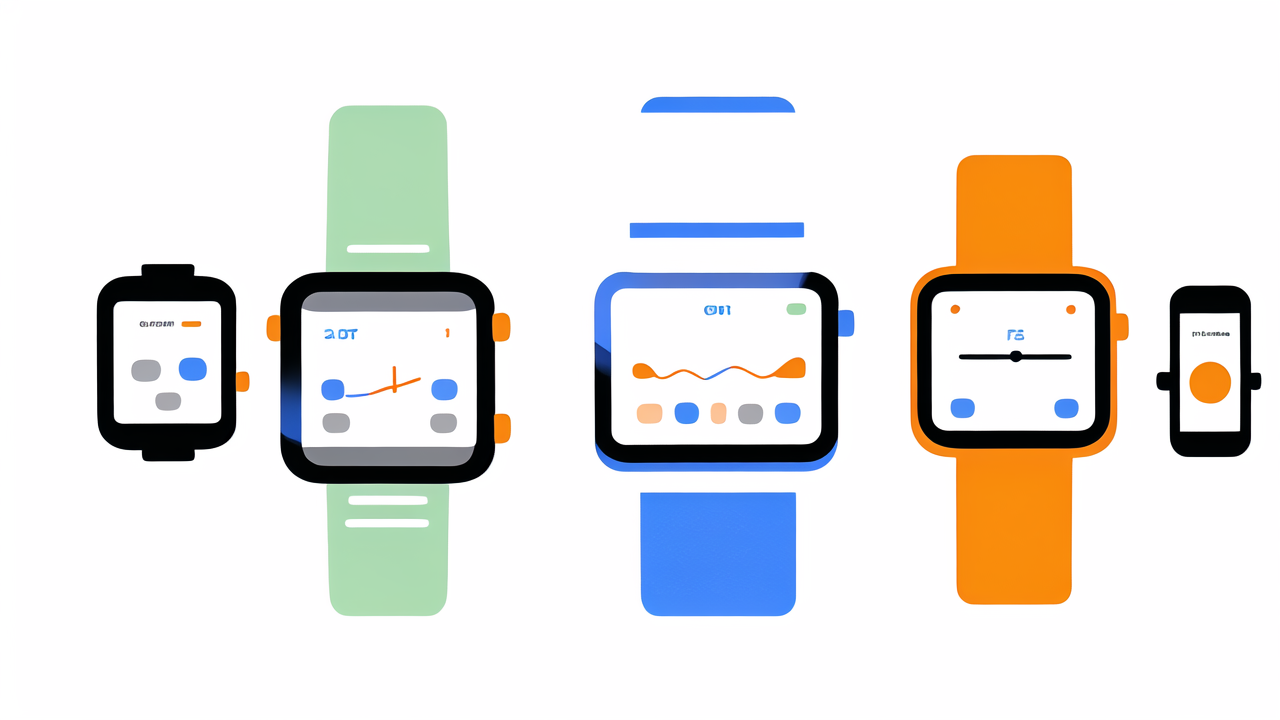Introduction to Smart Bracelets
The Origin of Pulse Watches
The journey of the smart bracelet began as a modest pulse watch, created to track the wearer's heart rate during exercise. Initially embraced by athletes and medical professionals, it served a functional purpose, but its potential was yet untapped. These early devices pioneered a movement that laid the groundwork for the diverse wearable technology market we see today. In essence, the origin of pulse watches marks the genesis of a tech revolution that seamlessly blends health monitoring with our everyday lives.

Advancements in Wearable Technology
Wearable technology has come a long way since its inception. Initially, gadgets like pulse watches were basic, limited to only a few functions. However, recent advancements have brought about a revolution in this sector. Today's smart bracelets are equipped with cutting-edge technology, allowing them to perform a multitude of tasks that go far beyond just tracking heartbeat or counting steps. It's not just the functionality that's impressive; the seamless integration with other smart devices like phones and tablets has also enhanced the user experience significantly. As a result, these devices are now an essential part of many people's lifestyle, helping them monitor their health, stay connected, and be more productive.
The Fitness Era
GPS and Heart Rate Monitoring Features
The 'Fitness Era' brought about a significant change in the way we track our physical activities, with the integration of GPS and heart rate monitoring features into smart bracelets. GPS, or Global Positioning System, allows users to accurately track their location, pace, and distance traveled during outdoor activities. Heart rate monitoring, on the other hand, provides real-time data on cardiovascular performance, enabling users to optimize their workouts based on their heart rate zones. These advancements have not only enhanced the accuracy of fitness tracking but also motivated individuals to pursue a more data-driven approach to health and wellness.
Impact on Health and Fitness Enthusiasts
The 'Fitness Era' marked a significant turning point in the journey of smart bracelets in the US. Health and fitness enthusiasts were quick to adopt this technology due to its transformative potential in tracking and improving workout regimens. With real-time access to data like heart rate and calories burned, users could better understand their physical activity and make informed decisions to enhance their performance and health. This personalized approach to fitness, enabled by smart bracelets, motivated individuals to set realistic goals and consistently monitor their progress. As these devices became quintessential to the fitness community, they also sparked conversations around health awareness and the importance of maintaining an active lifestyle.
Transition to Fashion Accessory
Design Evolution for Mainstream Appeal
As smart bracelets transitioned from fitness tools to trendy accessories, their design underwent significant changes. Initially, the focus was on functionality, with bulky frames and limited color options. However, manufacturers soon realized the need to blend tech with fashion, resulting in sleeker, more versatile designs. Metal finishes, customizable straps, and a variety of colors became available, making them suitable for different outfits and occasions. Such enhancements helped smart bracelets to appeal to a broader market, pushing them into the mainstream as both a tech gadget and a fashion statement.
Integration of Smart Tech with Style
Smart bracelets are no longer just about their tech-embedded functions; they have become a statement of style. The integration of smart technology with fashion has led to the creation of wearables that not only track fitness but also complement one’s personal style. Today's designs include sleek, minimalistic bands, as well as those that mimic the look of classic timepieces, complete with leather straps and metallic finishes. These stylish gadgets often offer customizable watch faces, allowing users to match them with their outfit or mood. Designer collaborations have also emerged, marrying high-tech features with high-fashion looks, signaling the shift towards wearables that cater as much to aesthetic preference as to functional necessity.
Technological Innovations
From High-End Watches to Affordable Gadgets
Smart bracelet technology has undergone a remarkable transformation, evolving from exclusive high-end models to more accessible devices. Initially, advanced features like GPS tracking and heart rate monitoring were limited to luxury watches, costing a small fortune. Today, these sophisticated capabilities are widely available at a fraction of the cost. The shift began as manufacturers sought to democratize wearables, making them economically feasible for a broader audience. This trend has led to an explosion in popularity, as fitness enthusiasts, tech-savvy individuals, and fashion-forward consumers can all find a smart bracelet that fits their budget and lifestyle. The affordability of smart bracelets has undoubtedly played a significant role in their widespread adoption and the growth of wearable technology as a whole.
The Role of Smartphones in Wearable Technology Growth
Smartphones have played a pivotal role in the growth of wearable technology, such as smart bracelets, in today's market. The widespread adoption of smartphones has paved the way for seamless integration with wearable devices. Users can now easily connect their smart bracelets to phone apps, unlocking a multitude of functions from fitness tracking to notifications. This synergy has not only made wearable devices more accessible but also more functional, as they leverage the computing power and connectivity of smartphones. With apps specifically designed to work with wearable tech, the smartphone's role extends beyond mere communication devices to become a central hub for managing health, entertainment, and productivity, all wrist-bound.
Consumer Trends in the US
Market Growth for Smart Bracelets
The smart bracelet market in the United States has witnessed a remarkable surge in growth. Consumer demand has accelerated, with more people adopting these gadgets as part of their daily lives. The popularity is partly due to the blend of functionality and convenience that smart bracelets offer, catering to health-conscious individuals and fashion-forward users alike. Industry reports highlight a steady increase in sales, signifying a shift in consumer preferences towards wearable tech that prioritizes both wellness and style. This trend is shaping how manufacturers design and market their products to an audience that values technology that can seamlessly integrate into their lifestyle.
Lifestyle Influence on Technology Adoption
In the United States, the adoption of smart technology is markedly shaped by lifestyle choices. People seek gadgets that blend seamlessly with their daily activities, whether for fitness, work, or social engagements. The surge in popularity of smart bracelets can be attributed to this cultural shift. Health-conscious individuals use wrist-worn devices to track their activities and vitals, such as steps and heart rate, while fashion-forward consumers appreciate the aesthetic and customization capabilities smart bracelets offer. More than just tech fans, everyday users are drawn to the practical and stylish nature of these devices, signifying a broader change in how technology is integrated into personal lives. Thus, lifestyles in the US are not just influencing tech trends, but are being shaped by them as individuals curate their tech use to fit their personal and social identities.
The Future of Smart Bracelets
Potential Features and Developments
The future of smart bracelets promises a blend of innovative features that could redefine personal technology. As the needs and desires of users evolve, developers are looking to incorporate cutting-edge functionalities such as enhanced biometric tracking, which could measure more than just heart rate and activity levels. Potential developments include stress detection, blood oxygen saturation, and even hydration levels. Additionally, we may see smart bracelets with AI capabilities that offer personalized health and wellness advice. Other anticipated advancements are extended battery life and more sophisticated integration with other smart devices, providing a seamless user experience. All these potential features aim to make smart bracelets an indispensable part of daily life, keeping users connected and health-conscious.
The Influence of Fashion on Future Designs
As we peer into the future of smart bracelets, the interplay between fashion and technology is poised to steer the course of wearable designs. Fashion-forward consumers are increasingly demanding not just functionality but also stylish accessories that complement their wardrobe. Designers are responding to this call by experimenting with a variety of materials, such as high-quality metals, leather, and discrete, chic shapes that can pair seamlessly with both casual and formal attire. In addition, we could see a blossoming of customizable options, enabling users to alter the look of their smart bracelets to match their outfit or mood for the day with interchangeable straps or digital watch faces. This marriage of aesthetics with technology highlights an exciting shift in how we may select wearable devices in the future, prioritizing a blend of utility and elegance.
Conclusion
Summary of the Evolution in the US
The journey of smart bracelets in the US vividly illustrates the remarkable transformation from performance-centric fitness tools to chic lifestyle accessories. The inception of pulse watches paved the way for a new category within wearable technology, focusing initially on health monitoring and physical activity tracking. Over time, with the introduction of features like GPS and heart rate monitoring, these devices began to resonate with health enthusiasts who valued data-driven insights into their daily routines.
As smart bracelets evolved, they transcended their fitness roots, adopting sleeker designs and a range of functionalities to appeal to a broader audience. By integrating smart tech with fashion, they emerged as a statement piece, catering not just to the health-conscious but also to the style-savvy consumer. This shift not only diversified their use-cases but also expanded their market reach.
The widespread adoption of smartphones accelerated the growth of wearable technology, as users sought seamless connectivity and instant notifications at their fingertips. Smart bracelets, once a niche luxury, became accessible, offering diverse features to meet varying consumer needs, hence amplifying their presence in everyday life.
In summary, the evolution of smart bracelets in the US reflects a dynamic interplay between technology, health, and fashion, showcasing a trend that is likely to continue shaping the wearable landscape for years to come.
The Outlook for Wearable Tech in Fashion & Fitness
As we look to the future, wearable tech, including smart bracelets, will undoubtedly continue to blur the lines between health tracking and high fashion. Current trends show a growing demand for devices that not only offer advanced health features and connectivity, but also complement personal style and offer a fashion statement. Fashion designers and tech companies may collaborate more closely, leading to beautifully crafted pieces that double as sophisticated accessories and practical health gadgets. The tech within these bracelets may see upgrades in battery life, sensor accuracy, and even more seamless smartphone integration. As functionality expands, we could witness the rise of smart bracelets that predict health trends, integrate with virtual assistants, or offer new forms of interaction. The fusion of fashion and fitness within wearable technology is expected to enrich and redefine the landscape of personal accessories in the US and beyond.




Leave a comment
This site is protected by hCaptcha and the hCaptcha Privacy Policy and Terms of Service apply.